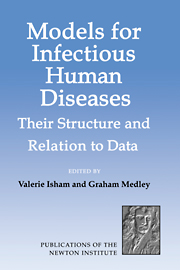Book contents
- Frontmatter
- Contents
- Introduction
- Participants
- Non-Participant Contributors
- Part 1 Transmissible diseases with long development times and vaccination strategies
- Part 2 Dynamics of immunity (development of disease within individuals)
- Part 3 Population heterogeneity (mixing)
- Modeling heterogeneous mixing in infectious disease dynamics
- Behavior change and non-homogeneous mixing
- Sources and use of empirical observations to characterise networks of sexual behaviour
- Invited Discussion
- Invited Discussion
- Per-contact probabilities of heterosexual transmission of HIV, estimated from partner study data
- Heterosexual spread of HIV with biased sexual partner selection
- Dynamic simulation of sexual partner networks: which network properties are important in sexually transmitted disease (STD) epidemiology?
- The spread of an STD on a dynamic network of sexual contacts
- Network measures for epidemiology
- Spatial heterogeneity and the spread of infectious diseases
- Data analysis for estimating risk factor effects using transmission models
- Homosexual role behaviour and the spread of HIV
- Homogeneity tests for groupings of AIDS patient classifications
- Risk factors for heterosexual transmission of HIV
- The effect of behavioural change on the prediction of R0 in the transmission of AIDS
- The saturating contact rate in epidemic models
- A Liapunov function approach to computing R0
- Stochastic models for the eradication of poliomyelitis: minimum population size for polio virus persistence
- Part 4 Consequences of treatment interventions
- Part 5 Prediction
Data analysis for estimating risk factor effects using transmission models
Published online by Cambridge University Press: 04 August 2010
- Frontmatter
- Contents
- Introduction
- Participants
- Non-Participant Contributors
- Part 1 Transmissible diseases with long development times and vaccination strategies
- Part 2 Dynamics of immunity (development of disease within individuals)
- Part 3 Population heterogeneity (mixing)
- Modeling heterogeneous mixing in infectious disease dynamics
- Behavior change and non-homogeneous mixing
- Sources and use of empirical observations to characterise networks of sexual behaviour
- Invited Discussion
- Invited Discussion
- Per-contact probabilities of heterosexual transmission of HIV, estimated from partner study data
- Heterosexual spread of HIV with biased sexual partner selection
- Dynamic simulation of sexual partner networks: which network properties are important in sexually transmitted disease (STD) epidemiology?
- The spread of an STD on a dynamic network of sexual contacts
- Network measures for epidemiology
- Spatial heterogeneity and the spread of infectious diseases
- Data analysis for estimating risk factor effects using transmission models
- Homosexual role behaviour and the spread of HIV
- Homogeneity tests for groupings of AIDS patient classifications
- Risk factors for heterosexual transmission of HIV
- The effect of behavioural change on the prediction of R0 in the transmission of AIDS
- The saturating contact rate in epidemic models
- A Liapunov function approach to computing R0
- Stochastic models for the eradication of poliomyelitis: minimum population size for polio virus persistence
- Part 4 Consequences of treatment interventions
- Part 5 Prediction
Summary
A major activity of both academic and governmental epidemiologists involves ascertaining the environmental contaminations, personal behaviors, biological factors, and other risk factors whose control will lead to the control of disease risks. Almost always the data analytic models used in this task are consistent with linear models of the causal process leading to disease. One of their basic assumptions is thus that the outcomes in one study subject are independent of the outcomes in other study subjects.
Infection transmission between humans is inconsistent with these linear model forms. Some particular consequences of this inconsistency explain why epidemiologists have been so unsuccessful in defining the modes of transmission of many infectious agents. Model inconsistencies also explain the poor performance of epidemiological methods in determining the relative importance of different factors contributing to infection risk at both an individual and a population level. It will be demonstrated how most of the effect of risk factors which increase transmission risk will not be detected by the usual analytic methods of epidemiology. This inadequacy of standard methods occurs even when contact patterns are random. It will be further demonstrated how non-random contact patterns can create additional difficulties for the detection of secondary risk factors.
Standard analytic models in epidemiology assume that causal actions occur directly on individuals. Thus their basic parameters are unlike those in transmission models which relate to interactions between individuals. The paradigm jump from cause acting directly on individuals to cause acting on interactions between individuals is a big one for epidemiologists. The paradigm jump would be facilitated if a data collection and analysis framework existed based on transmission models. Some approaches to developing that framework will be discussed.
- Type
- Chapter
- Information
- Models for Infectious Human DiseasesTheir Structure and Relation to Data, pp. 290 - 291Publisher: Cambridge University PressPrint publication year: 1996

